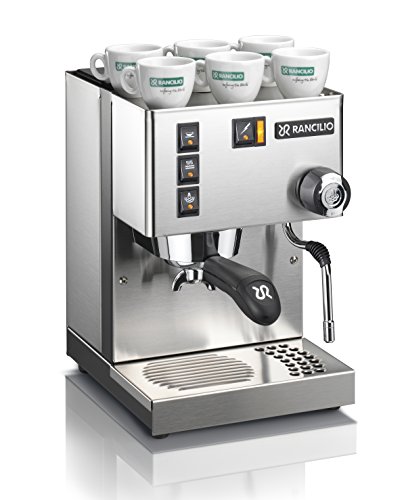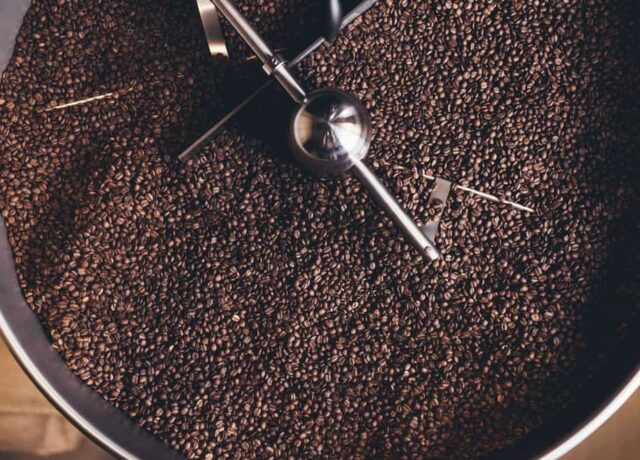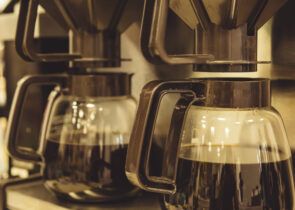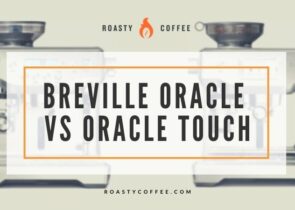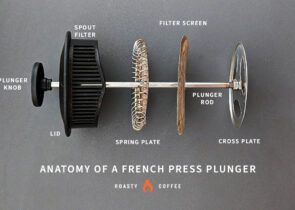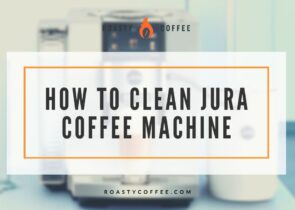There are tons of great espresso machines available for $1000 or less.
We’ve rounded up a few of our favorites, ranging from the cult-classic Rancilio Silvia, perfect for bonding in the coffee forums, to the Gaggia Anima Prestige, which just might be easier than running to the coffee shop.
Maybe you’re yearning to develop some barista skills and envision yourself dialing in your shot of espresso to your exact taste preferences. Or maybe you’re just sick of handing over cash at the coffee shop and are ready to brew your own specialty coffee beverages.
At a Glance: Best Espresso Machine Under $1000
Either way, if you’re in the market for an espresso machine, you’ve surely noticed that the range of options and prices is vast.
For under $1000, there are many manual, semi-automatic, and fully-automatic espresso machines that we can recommend with enthusiasm.
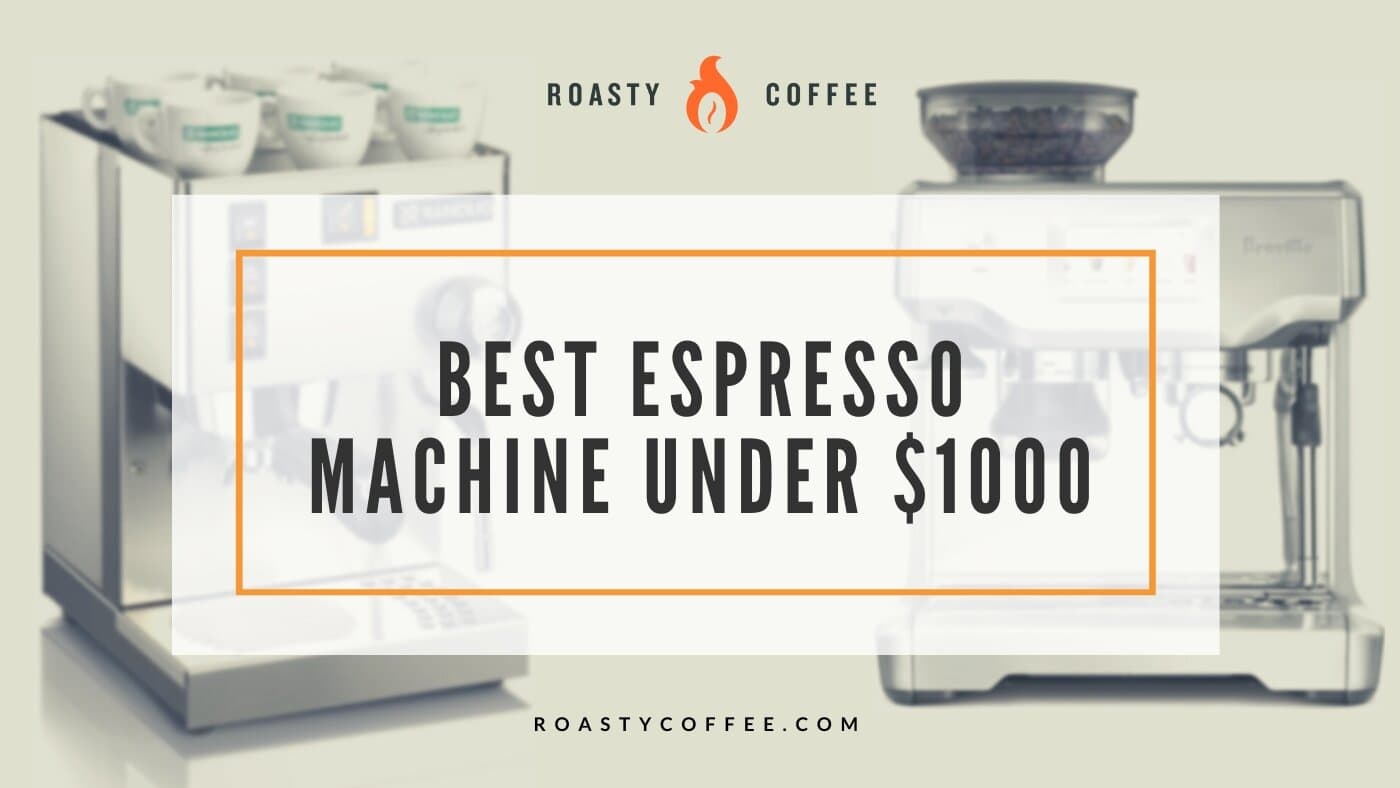
Quick Summary: Best Espresso Machine Under $1000
 | Our Top Choice Rancilio Silvia |
| Check on Amazon → |
 | Breville Barista Touch |
| Check on Amazon → |
 | La Pavoni Europiccola 8-Cup |
| Check on Amazon → |
 | DeLonghi Dinamica ECAM35020 |
| Check on Amazon → |
 | Jura ENA 4 |
| Check on Amazon → |
| No products found. | Gaggia Anima Prestige |
| Check on Amazon → |
Rancilio Silvia
The Rancilio Silvia is a cult-favorite semi-automatic espresso machine. It’s been in production since 1998, undergoing several updates yet remaining a popular choice for aspiring baristas who are ready to learn the ins and outs of making great espresso.
It has a 58-mm portafilter, which is larger than many home espresso machines and allows for more accurate grounds-to-water ratios. There’s no built-in grinder, so be sure to purchase a high-quality one to ensure the best possible espresso.
The Rancilio Silvia is constructed from metal, right down to the drip tray. That definitely gives it a sturdy, high-quality feel, but it also makes cleaning the machine extra important in order to avoid rust.
If you’ve been watching latte art tutorials and hoping to dive in, the Silvia has plenty of steam power for the job.
Because it has a single boiler and a thermostat, you’ll need to engage in some temperature surfing to ensure the best water temperature for brewing. It can be tricky to get the hang of this, but with practice, you can use this technique to improve the quality of your espresso.
Overall, this is a great machine for someone looking to get into a new hobby.
There will be plenty of tasting, tweaking, and re-adjusting to do, but sometimes it’s about the journey, not just the destination.
Things We Like:
- Sturdy, attractive metal construction
- Powerful steam wand
- Large, 58-mm portafilter
Things We Don’t Like:
- Single boiler and thermostat make it tough to nail down the right temperatures
Breville Barista Touch
The Barista Touch is a mid-range model machine from a well-known Australian manufacturer – Breville.
It’s a semi-automatic espresso maker, which means that it makes brewing espresso much more accessible, but doesn’t perform the whole process, like a fully automatic machine would.
It has a sleek, stainless-steel construction that looks high-quality and modern. Many espresso machines at this price point have a lot of plastic in their construction, so this is a stand-out.
This espresso maker comes with a 54-millimeter portafilter and a single (best for freshly ground espresso) and dual wall (best for pre-ground coffee) filter basket.
It also comes with a stainless steel tamper, which you’ll need because this espresso maker requires manual tamping. That’s okay – most baristas would prefer this option over automatic tamping anyway, so take it as an opportunity to pull a better shot by dosing and tamping your portafilter yourself.
As the name implies, the Barista Touch is operated via a touchscreen, which feels modern and super easy to navigate. You can use it to select from 8 preprogrammed drinks, which include a latte, flat white, cappuccino, and more.
All of these drinks are made possible by an automatic steam wand, which can be operated as a manual steam wand if you prefer to be a more hands-on home barista.
The Barista Touch, like all of the espresso machines on this list, has a single boiler. This means you’ll have to wait for it to reheat between making your espresso and steaming your milk.
However, you won’t be waiting long, because the heat-up time on this machine is only 3 seconds!
What We Like:
- Lots of pre-programmed drink options
- 30 grind levels
- Super fast heat-up time
What We Don’t:
- No auto-tamping option
La Pavoni Europiccola 8-Cup
The La Pavoni Europiccola is the only manual espresso machine on our list, and it’s the perfect choice for the aspiring espresso connoisseur.
You’ll need to be meticulous, patient, and willing to experiment and practice, but the result will be well worth the effort.
This espresso maker is stunning – there’s no doubt it will look great sitting on your counter. The lever and knobs give it some old-fashioned charm, but the chrome finish adds a sleek, modern flair to the design.
The triple-plated brass design and sleek chrome finish also make this espresso machine durable and easy to clean.
The Europiccola comes with two filter baskets – one that holds 9g, and one that holds 13g (the typical choice of espresso enthusiasts).
It also has two options for steaming milk. There’s an auto-frothing attachment, which will automatically draw up milk, froth it, and dispense it into your cup. If you’d like a little more control, choose the steaming wand instead to froth your milk exactly to your liking.
If you like the idea of learning to grind, tamp, and pull your shot perfectly, extracting it to your exact preferences, this is the espresso machine for you.
If you’d prefer the fruit with a bit less labor, consider one of our semi-automatic or automatic recommendations instead.
What We Like:
- Attractive and attention-grabbing design
- Durable build
- Automatic and manual milk steaming options
- Complete control over every step of the brewing process
What We Don’t Like:
- Not the best option if you’re in a hurry in the morning
- Cleaning is more cumbersome than some of our other recommendations
DeLonghi Dinamica ECAM35020
DeLonghi has just under two decades of producing super-automatic espresso machines under their belt, but machines like the Dinamica have become popular mid-range options.
Since this model is super-automatic, brewing a shot of espresso is extremely hands-off – just push a button and the Dinamica will take it from there.
This could make it appealing to beginners who are looking for a great-tasting shot but lack barista skills.
The Dinamica ECAM35020 has a 15-bar pressure pump, a manual Panarello wand for making milk foam, and a built-in conical burr stainless steel grinder with 13 settings. It also has a dual spout, so you can brew two shots at once if you have a kitchen full of people desperate for their espresso.
One more neat feature of this machine is that it can brew over ice at a cooler temperature, allowing you to whip up an iced latte that isn’t diluted.
What We Like:
- The brew-over-ice feature adjusts the grind and water amount and the brew temperature to make iced beverages that taste full-bodied and not watered-down.
- Super fast heat-up time of just 40 seconds
- Convenient and easy for espresso machine newbies
What We Don’t Like:
- Mostly plastic construction
- The Panarello wand produces foam that is just ok – and don’t expect any latte art
Jura ENA 4
Jura is a long-established brand in the world of superautomatic espresso makers, and most of these luxury coffee makers will set you back more than a grand.
However, the Jura ENA 4 squeaks in just under our budget for this article.
The Jura ENA 4, like all Jura coffee machines, is a super-automatic espresso machine with a built-in grinder. It’s ideal for the coffee lover who doesn’t want to customize their brew too much and prefers the ease and convenience of just pushing a button and watching the java drip out.
It has a compact footprint for this type of brewer and might be a good choice for small kitchens.
This machine makes excellent plain espresso, but it doesn’t have a built-in milk frother. That could be a deal-breaker if your ideal morning involves a cappuccino or other milk-based beverage.
The ENA 4 has a 15-bar pressure pump, which is more than sufficient to produce a shot of espresso. It has some stainless steel parts but is mostly plastic, which is a bummer but is also to be expected in the under-$1000 category.
What We Like:
- Jura’s Pulse Extraction Process and pre-infusion process guarantee rich and aromatic espresso
- Built-in stainless steel conical burr grinder
- Easy, one-button operation
What We Don’t Like:
- No milk frother
- Expensive for what you get
Gaggia Anima Prestige
No products found.
The Gaggia Anima Prestige is another fully automatic espresso machine, which means it brings significant convenience to the table.
It offers one-touch brewing, even for cappuccinos and lattes. This is an upgrade over what you’ll find in the other, lower-priced Gaggia Anima models.
The milk is steamed in an attached container, then dispensed directly into your cup. While the milk container adds a few necessary steps to the cleaning process for this machine, it also makes it so easy to brew your latte that you’ll be able to do it with half-closed, pre-caffeine eyes.
This machine features a flat ceramic burr grinder, which some coffee experts argue is better for preserving the flavor of the coffee during grinding than stainless steel.
If you’re short on kitchen space, the compact size of this machine might be just what you’re looking for. At 13.4 x 8.7 x 17.0 inches, it’s smaller than many of its competitors, and the built-in milk frothing container means you don’t need extra counter space for a separate carafe.
With 5 grind sizes, 5 espresso strength levels, and 3 water temperature options, you can do a fair bit of customization of your espresso shot.
Of course, if you’re looking for even more ways to dial in your brew, you might want to consider one of the manual or semi-automatic options instead.
What We Like:
- Super convenient, one-button use
- Compact design
- Customization options for grind size, strength level, and temperature
What We Don’t Like:
- The milk frothing container is a bit cumbersome to clean
Important Considerations
Before you select one of these espresso machines and get brewing, there are some important topics to consider.
Manual, Semi-Automatic, or Fully Automatic?
There are three types of espresso machines you’ll need to choose from, and each has its advantages and disadvantages.
Manual espresso machines are the most labor-intensive and require the most additional gear. You’ll need a separate grinder to grind your beans and a scale to dose your portafilter and weigh your yield (the amount of espresso that comes out of the machine).
You’ll be doing each step yourself – grinding, dosing, tamping, and pulling the shot. This is the preferred option for most espresso connoisseurs because it allows for the highest level of control. It’s also the most difficult and might not be the best choice for beginners.
Semi-automatic machines have some automated elements and some that must be done by the user. For example, the Breville Barista Touch will grind your beans and pre-infuse and pull your shot for you, but you’ll have to tamp the grounds yourself between the grinding and brewing process.
These machines might be a good option for you if you’d like a little more control, but don’t want to manage every aspect of your brew just yet.
Fully automatic or super-automatic machines are just what they sound like – they take whole beans and a carafe of milk and deliver you a latte, just like a little barista on your countertop.
Their biggest advantage is their undeniable convenience, but they have disadvantages too. There’s little to no opportunity for tweaking and dialing in your espresso, and as a result, there’s a ceiling on just how perfect the brew can be.
Also, a quality super-automatic machine is expensive, so you might find yourself making concessions in other areas to stay within your price range.
For example, the fully automatic machines on our list tend to have plastic rather than metal construction and some had underwhelming (or in the case of the Jura ENA 4, absent) milk frothing systems.
Boilers
The boiler is the part of the espresso machine responsible for heating water for both brewing and for steaming milk – so it’s safe to say that this is a pretty important part!
Transitioning between the ideal temperature for steaming milk and the ideal temperature for brewing espresso takes time, but in the under-$1000 segment, it’s pretty much unavoidable.
All of our recommended machines have a single boiler.
The good news is that many of our favorite espresso makers do this pretty quickly. The DeLonghi Dinamica and the Breville Barista Touch in particular have super-fast heat-up times.
Pressure
A bar is a metric unit of pressure that is just about equivalent to the atmospheric pressure on Earth at sea level.
Since espresso is brewed under pressure, you’ll often see mention of the number of bars of pressure a machine can achieve.
While you’ll see 9-bar, 15-bar, and even higher-bar espresso machines, more isn’t better in this case. The ideal amount of pressure for brewing espresso is 9 bars, and more pressure won’t make a better brew.
A 15-bar or higher espresso machine is typically cheaper and is losing a lot of that pressure between the pump and the group head where the espresso is brewed. By the time the water hits the grounds, it’s likely closer to 9 bars of pressure.
In our research at this price point, 15-bar machines were pretty common.
Grinder
Your espresso can only be as good as its grind, so you’ll need to consider whether you choose a machine with a built-in grinder or one that will require a stand-alone espresso grinder in your setup.
If you choose to buy a separate grinder, remember to consider the price of the grinder in your espresso machine budget. The Baratza Sette 30 is one that we particularly like.
As for buying a machine that has a built-in grinder, you’ll want a burr grinder with several grind settings.
As for whether you choose a ceramic or stainless steel grinder, experts don’t fully agree. Ceramic grinders might be slightly better for preserving the flavor of the beans, while stainless steel is less likely to chip.
Frequently Asked Questions
How Many Bars of Pressure Is Good For An Espresso Machine?
The sweet spot for pulling a perfect shot of espresso is 9 bars of pressure. You may see machines advertised that offer more than 9 bars of pressure, but in reality, more isn’t necessarily better.
Much of that extra pressure is probably being lost, and by the time it reaches the group head, the pressure is closer to the ideal 9 bars.
Is An Expensive Espresso Machine Worth It?
While expensive is a relative term, we think it’s certainly worthwhile to splash out a little extra cash if you’re serious about your espresso.
In the under-$1000 price range, you can find plenty of espresso machines that are attractive, convenient to operate, make delicious espresso and other beverages, and that are built to last.
If you have the money to spend, we think you won’t regret the investment.
Our Takeaways
If your love of espresso has finally inspired you to bring home your own machine, do a little soul-searching.
Are you looking for a new hobby, lots of experimentation, and the thrill of trial and error in pursuit of the perfect espresso?
If so, try a manual machine like the La Pavoni Europiccola or an involved semi-automatic like the Rancilio Silvia.
On the other hand, maybe you want your espresso brewing experience to be a little more similar to visiting your favorite coffee shop – order something up and wait for it to pour into your mug.
If that’s the case, try a fully automatic machine or a less involved semi-automatic like the Breville Barista Touch.
Whatever you choose, we wish you all the best on your home barista adventure.
Happy Caffeinating!

